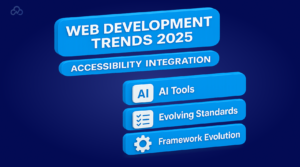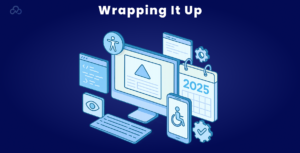Here’s the thing,if you still think accessibility is just a “nice to have,” you’re already behind the curve. WHO’s 2023 numbers? 1.3 billion people,yeah, billion,living with some form of disability. That’s not niche that’s one in six humans on Earth. And yet, WebAIM’s 2024 audit? Only 3% of sites built with modern web development frameworks actually meet WCAG standards. Three percent.
Pretty wild, right? Especially in 2025, when nearly everything,shopping, job hunting, paying bills, even ordering a coffee,happens online. And here’s the kicker,no, the punch to the gut: accessibility-first isn’t some fluffy “nice thing to do.” It’s legal cover, a growth play, and in plenty of cases, the sneaky shortcut to better SEO.
The upside? Today’s web development frameworks (React, Vue, Next.js,take your pick) plus better responsive web design make this stuff way less painful than it used to be. Throw in DevOps consulting services or go full DevOps as a service, and you’ve got a setup that works for users, dev teams, and yes,your bottom line.
The Business Case for Accessibility in 2025
A. Market Statistics and Demographics
People call it the “disability market,” but that makes it sound small. It’s not. We’re talking about a $13 trillion annual disposable income slice of the global economy. Companies leaning into web development trends 2025, and actually using web development frameworks with built-in accessibility features, are setting themselves up to grab some of that.
And it’s not just about people already in that demographic. By 2030, one in six people will be over 60. Translation: more folks squinting at screens, moving slower through sites, and expecting you to make it easy. Ignore that, and you’re basically hanging a “not welcome” sign in your shop window.
|
Region |
Annual Disposable Income (Trillions) |
|
North America |
$3.5T |
|
Europe |
$2.8T |
|
Asia-Pacific |
$4.2T |
|
Others |
$2.5T |
Bottom line? Use the right web development frameworks, and you’re not just ticking a compliance box, you’re building something more people can and will actually use.
B. Legal and Compliance Landscape
Here’s where it gets messy,2025 is a minefield if you’re pretending accessibility isn’t your problem. The European Accessibility Act (EAA) starts enforcement in June. Over in the US, the ADA’s digital rules are tightening. In 2023 alone? 4,600+ lawsuits hit inaccessible sites. Spoiler: that curve is going up, not down.
Settlements? $25k to $75k is common, and that’s before PR cleanup. The fix? Start with accessibility on day one. Use web development frameworks that support semantic HTML, ARIA roles, proper navigation. Tie in DevOps consulting services to automate checks, and let DevOps as a service keep them running. Skip that, and you’re just betting against your own bank account.
C. SEO and Performance Benefits
Here’s the part most people don’t realise, accessibility-first design isn’t just good for users, it’s good for your search rankings. Responsive web design, clean semantic markup, and optimised code, things that come naturally from modern web development frameworks, feed directly into Core Web Vitals. Google loves that stuff.
Sites that meet accessibility standards tend to load faster, work better on mobile, and keep bounce rates low. If you’ve got DevOps as a service running your CI/CD, you can have automated accessibility audits run alongside performance testing. That way, you’re not just “passing tests,” you’re shipping high-performing, high-ranking sites that more people can actually use.
Modern Web Development Frameworks Supporting Accessibility
This is where the technological magic takes place. Not all web development frameworks are made equal, and some are making accessibility a priority rather than an afterthought in 2025.
– React 18+ – Focus management is no longer a hassle, and ARIA support is at last respectable. It’s no longer stuck in a modal bug.
– Angular 17 – CDK accessibility modules are built right in. Saves you hours, unless you forget they exist, which, don’t.
– Vue 3.4 – Better screen reader announcements. Not flashy, but your users will thank you.
– Next.js 14 – Does accessibility audits in dev. Yes, it nags you. That’s a good thing.
And then you’ve got component libraries that don’t just “look nice,” but are genuinely responsive web design friendly and score high on WCAG compliance:
|
Library |
WCAG AA Compliance Score |
|
Radix UI |
98% |
|
Arco Design |
95% |
|
Material-UI |
93% |
|
Ant Design |
91% |
Tie this to DevOps consulting services or DevOps as a service, and suddenly your CI/CD pipeline isn’t just testing for broken code, it’s testing for whether your site is usable by someone with a screen reader or who navigates entirely by keyboard.
Technical Implementation Strategies
Let’s be real,skip the basics and no fancy framework is going to save you.
Semantic HTML + ARIA – Headings in order. Not <div> soup. Add ARIA landmarks. Label your buttons, make live regions actually talk, and for the love of all that’s good, stop shipping forms that just flash red boxes when something’s wrong.
Responsive web design – Not just about breakpoints. Hit targets need to be tappable (44x44px minimum). Don’t make swipe the only option. And test zoom at 200%,seriously, do it. If your layout explodes, fix it.
Performance with accessibility – Lazy load your images but give screen readers a heads-up. Use progressive enhancement so even if scripts fail, people can still use your site.
Testing – axe-core or Pa11y will catch most stuff, but real users with assistive tech catch what you can’t fake. And having tabbed through it is not testing.
Case Studies & Implementation Examples
– Microsoft Teams (2023–2024) – A full accessibility overhaul lifted satisfaction among disabled users by 40% and dropped support tickets by 23%. Not just nice numbers,less fire-fighting for the dev team.
– Target – Accessibility improvements pushed conversion rates up 13%, adding $6.9M in revenue. That’s not “feel good” PR, that’s money in the bank.
– UK.gov – Hit 97% WCAG AAA compliance and cut user errors by 31%. Which means fewer frustrated citizens and fewer complaint emails.
These aren’t just feel good stories. They’re proof that accessibility pays, financially and operationally.
Web Development Trends 2025: Accessibility Integration

Accessibility is now baked into web development trends 2025 in three big ways:
1. AI tools – Auto alt-text that’s actually passable now, real-time captions, even voice navigation. No, it’s not perfect, but it’s miles ahead of 2020.
2. Evolving standards – WCAG 3.0, ARIA 1.3, and mobile-first accessibility guidelines are examples of evolving standards. You will have to spend more money fixing later if you don’t keep up.
3. Framework evolution – In contemporary web development frameworks, components now have built-in reports, compliance scores, and smarter defaults.
Technical FAQs
Q1: How do modern web development frameworks handle dynamic content accessibility?
They sync virtual DOM updates with ARIA live regions, then manage focus so users don’t lose their place. Basically, they stop your app from feeling like a maze.
Q2: Does adding accessibility tank performance?
Nope. If you do it right, it’s 3% overhead at most. You won’t even feel it.
Q3: How do DevOps consulting services add accessibility testing to pipelines?
Plug in axe-core or Pa11y to Jenkins, GitHub Actions,whatever you’re using. It’ll nag you early, which is better than late.
Q4: What’s needed for WCAG 2.2 AA in SPAs?
Router accessibility, screen reader state announcements, async content that doesn’t sneak in without saying hello.
Wrapping It Up

2025 is the year accessibility stops being extra credit. Laws are here, the market’s huge, and web development trends 2025 are making it part of the core build process. Web development frameworks are smarter, and DevOps as a service can keep accessibility checks on autopilot.
So yeah, if you haven’t already, audit your site. Patch the obvious holes. Then bake accessibility into your responsive web design so it’s just how you work. Do that, and you’re not just dodging lawsuits, you’re making something people can actually use, enjoy, and tell others about. And if that’s not enough… well, you’ll find out the hard way.
Do you like to read more educational content? Read our blogs at Cloudastra Technologies or contact us for business enquiry at Cloudastra Contact Us